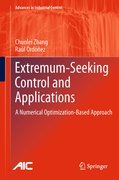
Extremum-seeking control and applications: a numerical optimization-based approach
Zhang, Chunlei
Ordóñez, Raúl
Extremum-seeking control tracks a varying maximum or minimum in a performancefunction such as output or cost. It attempts to determine the optimal performance of a control system as it operates, thereby reducing downtime and the need for system analysis. Extremum-seeking Control and Applications is divided into two parts. In the first, the authors review existing analog-optimization-based extremum-seeking control including gradient-, perturbation- and sliding-mode-based control designs. They then propose a novel numerical-optimization-based extremum-seeking control based on optimization algorithms and state regulation. This control design is developed for simple linear time-invariant systemsand then extended for a class of feedback linearizable nonlinear systems. Thetwo main optimization algorithms – line search and trust region methods – areanalyzed for robustness. Finite-time and asymptotic state regulators are put forward for linear and nonlinear systems respectively. Further design flexibility is achieved using the robustness results of the optimization algorithms and the asymptotic state regulator by which existing nonlinear adaptive control techniques can be introduced for robust design. The approach used is easier toimplement and tends to be more robust than those that use perturbation-based extremum-seeking control. The second part of the book deals with a variety of applications of extremum-seeking control: a comparative study of extremum-seeking control schemes in antilock braking system design; source seeking, formation control, collision and obstacle avoidance for groups of autonomous agents; mobile radar networks; and impedance matching. MATLAB®/Simulink® code which can be downloaded from www.springer.com/ISBN helps readers to reproduce the results presented in the text and gives them a head start for implementing the algorithms in their own applications. Extremum-seeking Control and Applications will interest academics and graduate students working in control, and industrial practitioners from a variety of backgrounds: systems, automotive, aerospace,communications, semiconductor and chemical engineering. Provides the reader with a new and more robust method of control for reducing plant downtime and time-consuming system analysis. Presents several applications of extremum-seeking control demonstrating its practical appeal in diverse circumstances. Provision of MATLAB®/Simulink® code gives readers a head start for implementing the algorithms descrived in their own applications. INDICE: Part I: Theory. Introduction. Design of Extremum-seeking Control. Finite-time State Regulator Design.-Asymptotic State Regulator Design. Part II: Applications. Antilock Braking systems. Swarm Tracking. Impedance Matching. Mobile Radar Network. Appendix: Construction of Reference Signal.
- ISBN: 978-1-4471-2223-4
- Editorial: Springer London
- Encuadernacion: Cartoné
- Páginas: 195
- Fecha Publicación: 30/11/2011
- Nº Volúmenes: 1
- Idioma: Inglés
